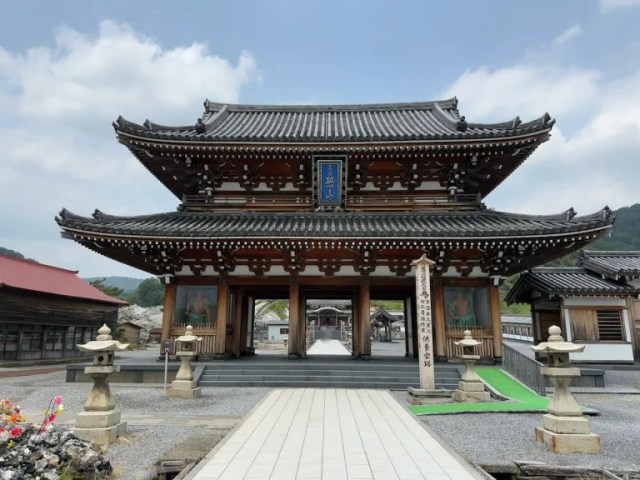
We find hell and paradise both at Aomori’s Osorezan.
If you keep heading north as far as you can on Japan’s main island of Hokkaido, you’ll come to Aomori Prefecture, and if you keep heading north as far as you can in Aomori, you’ll eventually arrive at the Shimokita Peninsula. Shimokita isn’t just the end of the line in a geographic sense, though, but in a figurative, spiritual one too, as the peninsula is where you’ll find Osorezan, or Mt. Osore.
Osore is the Japanese word for “fear” or “terror,” and Osorezan, with its desolate rocky terrain and sulfuric gas seeping out from below ground, is felt to bear more than a passing resemblance to Buddhist descriptions of hell and the afterlife. Osorezan is considered one of the three most sacred places in Japan as a gathering place for spirits of the dead, and on her recent travels in northern Japan, our Japanese-language reporter Saya Togashi decided to make her first visit.
As you might expect for someplace that’s thought of as a meeting point between our world and the afterlife, Osorezan is a bit out of the way. The closest train stop is Shimokita Station on the Ominato Line, and from there it’s a 45-minute drive or bus ride to Bodaiji, Osorezan’s temple.
As she approached the temple, Saya began smelling sulfur and seeing jizo, roadside statues of monks meant to serve as guiding protectors of travelers and children, including those who died during childbirth.
As a famous temple, Bodaiji (which is open from May 1 to October 31 and closed to visitors the rest of the year) gets its share of sightseers during festivals. But on the day Saya visited, there were no special events planned, and she had the place almost completely to herself.
It wasn’t just the lack of crowds that created an atmosphere of isolation, either. Many of Japan’s prominent temples, such as the ones you’ll find in Kyoto and Nara, were built in cities that were already large at the time of the temples’ founding, and which have seen continued development in the years since. Bodaiji’s surroundings, though, are thoroughly rural, and the unobstructed views of wide expanses of sky also contributed to a mysterious feeling as Saya walked toward the entrance to the temple grounds.
Admission is 700 yen (US$4.65) and includes access to the interior of the main hall, which houses a Jizo Bodhisattva/Ksitigarbha statue (photography is not allowed inside the hall). Bodaiji also has a temple lodge where travelers can spend the night, and Saya was surprised to learn that there are even hot spring baths.
▼ The hot spring bath buildings
But more than any of the buildings or man-made facilities, it’s the natural scenery that brings people to Osorezan.
As Saya went deeper into the rocky terrain, the smell of sulfur intensified, and she began to see piles of rocks that other visitors had made, following the folklore that says doing so will make it easier for souls to reach the far side of the Sanzu River, a mythical waterway they must cross as part of their voyage to the afterlife.
▼ Groundwater running yellow after mixing with sulfur
Another unique sight of Osorezan are pinwheels.
The cheerful-looking markers are said to help comfort and shepherd the souls of stillborn children. For a 500-yen donation, visitors can purchase one to place on he grounds.
Though Saya knows the scientific explanation probably has something to do with variations in air flow as wind blows over the rocky hills, plus subtle variations in construction from piece to piece, more than once she felt like a section of pinwheels that had been motionless as began to spin as she drew near, only to abruptly stop once she’d walked past them. She also observed times when a single pinwheel would seem to spring to life all by itself, spinning around and around while its neighbors stayed still.
Along the route are various markers, likening specific spots to the 136 hells of Japanese Buddhist belief. But for those who persevere and make it past them…
…the beautiful Lake Usori is waiting for you.
This tranquil body of water sits in the mountain’s caldera, and is so expansive that it sometimes feels more like you’re looking out at the ocean (and much like the ocean, the water isn’t drinkable, though due to its sulfur content, not salt), The view from the shore is so calming that it’s come to be called Gokurakuhama, or “Paradise Beach.”
Having put in a lot of steps getting here, Saya decided to sit down and rest for a while, and her thoughts drifted to how different Osorezan feels from Wakayama Prefecture’s Koyasan and Kyoto’s Hieizan, the other two members of Japan’s three most sacred places for spirits of the deceased. At Koysan and Hieizan, it was the temple buildings themselves that left the deepest impression on Saya, with their culturally significant architecture giving them a sense of spectacle and majesty.
At Osorezan, though, it’s the open-air areas where Saya felt the strongest sense of place. In the solitude of unfamiliar scenery, Saya found herself repeatedly thinking of her parents, who passed away more than 10 years ago, and she’s honestly not sure how long she sat there thinking about the flow of time and humanity from the past to the present, and from the present to the future.
Leaving the temple and heading back to her car, Saya felt like her body and soul had both just gone on a little journey, and while she realizes Bodaiji’s location means it isn’t the easiest place to get to, she thinks it’s definitely worth the extra effort.
Temple information
Bodaiji / 菩提寺
Address: Aomori-ken, Mutsu-shi, Tanabyusoriyama
青森県むつ市田名部宇曽利山3-2
Website
Open May 1-October 31
Website
Photos ©SoraNews24
● Want to hear about SoraNews24’s latest articles as soon as they’re published? Follow us on Facebook and Twitter!
[ Read in Japanese ]